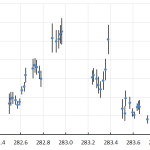Abstract: A new minor shower has been detected in the 2019 orbit data of CAMS. The shower displayed a first outburst during 2019, October 17-18 and a second one in the period 2019 November 11-18. The shower has been added to the IAU working list of meteor showers with the name 29 Piscids.
1 Introduction
Some unusual meteor shower activity has been observed in mid-October 2019 from a low-inclination stream. Already in 2014, six meteors from this stream were detected by CAMS California. The shower has been listed in the working list of meteor showers of the IAU Meteor Data Center as the 29 Piscids (PIS#1046).
During 2019 Oct. 17–18 UT, a cluster of 26 meteors was detected with a radiant near 29 Psc by nearly all of the CAMS low-light video networks (Jenniskens et al., 2011). The combined activity period extended from solar longitude 202.3° to 205.0° (equinox J2000.0) with a maximum on λʘ = 204.0 ± 0.1° (Figure 1, see also near the anti-helion source at the website for days of October 17–19). The shower parameters have been listed in Table 1.

Figure 1 – The radiant map based on the orbit data with the 29 Piscids recorded by CAMS.
2 Reappearance one month later
One month later, during 2019 Nov. 11–18 UT, another period of outburst activity has been observed that appears to be associated with the same parent body, given the similar eccentricity and longitude of perihelion of the orbit, when 93 meteors were triangulated. Activity stretched between solar longitude 228.3° and 234.9° and peaked at 231.4° (look on the website for the dates of 2019 Nov. 11–18).
There is a distinct trend of q versus Node Ω, and the November observations align with those from October approximately as
q = 0.318 + 0.36519 * log(Ω),
for the Node Ω in the range of 23–54°. So far, the shower has not been detected in 2020.
Table 1 – The 29 Piscids (PIS#1046). (J2000.0) with the orbits for the October and November outbursts.
| PIS (#1046) October 2019 |
PIS (#1046) November 2019 |
|
| λʘ | 204.0° | 231.4° |
| αg | 4.3 ± 0.6° | 6.8 ± 1.1° |
| δg | –2.7 ± 0.5° | –7.2 ± 1.2° |
| vg | 15.2 ± 1.3 km/s | 10.8 ± 1.4 km/s |
| a | 2.83 A.U. | 3.10 A.U. |
| q | 0.8166 ± 0.0096 A.U. | 0.943 ± 0.007 A.U. |
| e | 0.709 ± 0.069 | 0.693 ± 0.103 |
| ω | 55.3 ± 0.9° | 27.5 ± 1.7° |
| Ω | 24.1 ± 0.6° | 51.3 ± 1.6° |
| i | 1.9° ± 03 | 2.7 ± 0.4° |
| Π | 79.1 ± 0.6° | 78.9 ± 0.9° |
| TJ | 2.88 | 2.79 |
| N | 26 | 93 |
Acknowledgment
The following “Cameras for All-sky Meteor Surveillance” (CAMS) Networks contributed to the above results: California (coordinated by P. Jenniskens), CAMS Florida (A. Howell), CAMS BeNeLux (C. Johannink), CAMS New Zealand (J. Baggaley), Lowell Observatory CAMS (N. Moskovitz), UAE Astronomical Cameras Network (M. Odeh), CAMS South Africa (T. Cooper), CAMS Arkansas (L. Juneau), CAMS Australia (M. Towner), CAMS Chile (S. Heathcote and E. Jehin), and CAMS Namibia (T. Hanke).
References
Jenniskens P., Gural P. S., Grigsby B., Dynneson L., Koop M. and Holman D. (2011). “CAMS: Cameras for All-sky Meteor Surveillance to validate minor meteor showers”. Icarus, 216, 40–61.
Jenniskens P. (2020). “29 Piscids meteor shower in 2019”. CBET 4882.


